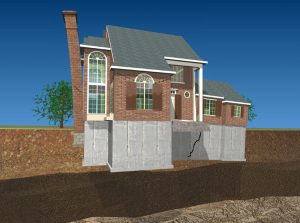Home Inspection Star will perform the foundation inspection per Internachi and “IL Home Inspector Standards of practice”.
The inspector shall inspect:
The foundation,basement,crawlspace; and structural components.
The inspector shall describe: the type of foundation and the location of the access to the under-floor space. The inspector shall report as in need of correction:
- observed indications of wood in contact with the soil
- observed indications of active water.
Not required to :
Enter any crawlspace that is not readily accessible, or where entry could cause damage or pose a hazard to him/herself
Move stored items or debris or to operate sump pumps with inaccessible floats.
Identify the size, spacing, span or location or determine the adequacy of foundation bolting, bracing, joists, joist spans or support systems.
Provide any engineering or architectural service. required to report on the adequacy of any structural system or components.
We do not perform “foundation inspections” outside of the scope of the home inspection. We recommend hiring a foundation repair contractor or a structural engineer if necessary.
An accurately constructed foundation supports your home well for a number of years. New owners of the house should focus on thought when the home inspector checks the foundation of their new home.
The home inspector Is NO required to inspect :
Recreational facilities or playground equipment.
Seawalls, break walls or docks.
Erosion-control or earth-stabilization measures.
Safety-type glass.
Underground utilities and underground items.
Wells or springs.
Solar, wind or geothermal systems.
Swimming pools or spas.
Wastewater treatment systems, septic systems or cesspools.
Irrigation or sprinkler systems.
Drain fields or dry wells.
What is the inspector looking at when performing the “foundation inspection”?
Proper drainage is among the main points that home inspector should look for when inspecting the foundation.
Your home inspector should be anxious with whether your home has correct drainage. New homeowners may not be conscious that this is fundamentally significant.
Inappropriate drainage can cause your foundation to crack, crumble and ultimately fail.
Soil shifting takes place when soil dries or is unevenly moist. The home inspector should look for areas where the soil is pulling away from the building.
Cracks, Buckling and Crumbling whil. Older homes may have little cracks. Look at cracks that lengthen up walls or appear in supportive areas. Clasping of basement floors is a suggestion of foundation issues. Dissolution of basement or foundation walls point out water damage.

Your home inspector should pay close concentration to the grade or slope of the property. Water should lope logically downhill, away from the foundation.
The gutters shoud direct water away from foundation wall. Superior adjacent properties could direct rainfall away from their home and into yours.
Keep in mind that molds grow fast. If you distinguish mold in your basement or on foundation walls, probability is this home has some leakage, or has not been draining appropriately recently.
